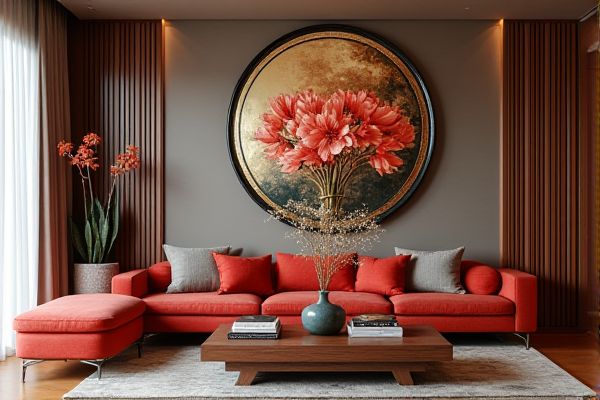
Hand-painted furniture offers unique, artistic charm with intricate designs and personalized details, while lacquered furniture provides a sleek, durable finish that enhances durability and ease of maintenance. Discover how to choose between these distinctive styles to elevate your home decor by reading the rest of the article.
Table of Comparison
| Feature | Hand-Painted Furniture | Lacquered Furniture |
|---|---|---|
| Appearance | Unique artistic designs, detailed craftsmanship | Smooth, glossy finish with uniform color |
| Durability | Moderate; susceptible to scratches and fading | Highly durable; resistant to scratches and moisture |
| Maintenance | Requires gentle cleaning; prone to wear over time | Easy to clean; retains shine with minimal effort |
| Cost | Generally higher due to craftsmanship | Moderate; mass-produced options available |
| Customization | Highly customizable and unique | Limited designs; uniform finish |
| Repairability | Can be restored by skilled artists | Repairs may be noticeable, requires professional refinishing |
| Environmental Impact | Often uses eco-friendly paints and techniques | May involve chemicals and solvents |
Understanding Hand-Painted Furniture
Hand-painted furniture showcases intricate artistry with unique brush strokes and customizable designs that highlight craftsmanship and individuality. Each piece carries subtle variations in texture and color resulting from manual application, providing a distinct, authentic character not achievable with machine finishes. This method also allows for greater creative expression, making hand-painted furniture a personalized and often more valuable choice than lacquered alternatives.
Exploring Lacquered Furniture
Lacquered furniture features a durable, glossy finish created through multiple layers of lacquer that provide excellent protection against scratches and moisture. This type of finish enhances the natural grain and color of the wood while offering a sleek, modern aesthetic ideal for contemporary interiors. Compared to hand-painted furniture, lacquered pieces require less maintenance and deliver a longer-lasting shine that resists fading and chipping.
Artistic Techniques: Hand-Painting vs Lacquering
Hand-painted furniture showcases intricate brushwork and unique artistic expression, often featuring detailed motifs, textures, and color variations that highlight craftsmanship. Lacquering involves applying multiple layers of varnish or resin, creating a smooth, glossy surface that enhances durability and provides a sleek, uniform finish. Both techniques reflect distinct artistic traditions, with hand-painting emphasizing individual creativity and lacquering focusing on protective elegance and refined aesthetics.
Durability and Longevity Comparison
Hand-painted furniture offers a unique, customizable finish but tends to be less durable over time due to its susceptibility to chipping, fading, and wear from daily use. Lacquered furniture provides a hard, protective coating that resists scratches, moisture, and UV damage, significantly enhancing longevity and making it ideal for high-traffic areas. For Your investment, lacquered pieces often maintain their appearance and structural integrity longer, requiring less maintenance compared to hand-painted alternatives.
Aesthetic Appeal and Design Versatility
Hand-painted furniture offers unique aesthetic appeal through intricate, customizable designs that highlight artisanal craftsmanship, making each piece a distinctive work of art. Lacquered furniture provides a sleek, glossy finish with a smooth surface that enhances color vibrancy and durability, suited for modern and minimalist interiors. Your choice depends on whether you prefer the personalized charm of hand-painted details or the sophisticated elegance and design versatility of lacquered finishes.
Surface Texture and Finish Quality
Hand-painted furniture boasts a unique surface texture characterized by visible brushstrokes and slight variations that enhance its artisanal charm, resulting in a rich, tactile finish. In contrast, lacquered furniture offers a smooth, glossy, and uniform surface that provides high durability and resistance to scratches. The finish quality of hand-painted pieces often reflects meticulous craftsmanship, while lacquered finishes deliver a sleek, modern aesthetic with long-lasting protection.
Maintenance and Care Requirements
Hand-painted furniture requires gentle cleaning with mild soap and water to preserve its intricate designs and typically benefits from periodic touch-ups to maintain vibrancy. Lacquered furniture demands careful avoidance of abrasive materials and exposure to direct sunlight to prevent cracking and discoloration, and it often needs polishing with specialized products to preserve its glossy finish. Both types should be kept away from extreme humidity and temperature fluctuations to ensure longevity and maintain aesthetic appeal.
Environmental Impact and Materials Used
Hand-painted furniture often utilizes natural, non-toxic paints derived from minerals and plant-based pigments, resulting in a lower environmental footprint compared to lacquered furniture, which typically involves synthetic chemicals and solvents that emit volatile organic compounds (VOCs). The application of hand-painted finishes requires less energy and produces minimal hazardous waste, whereas lacquered furniture manufacturing involves multiple coats of chemical-based lacquer that contribute to air pollution and resource consumption. Choosing hand-painted furniture supports sustainable practices by favoring biodegradable materials and reducing reliance on petrochemical products commonly found in lacquered finishes.
Cost Considerations and Value
Hand-painted furniture often involves higher labor costs due to the meticulous craftsmanship required, making it more expensive than lacquered furniture, which benefits from faster application techniques. The unique artistry of hand-painted pieces can significantly increase their value and appeal as one-of-a-kind items, while lacquered furniture offers a sleek, durable finish with comparatively lower production expenses. Investing in hand-painted furniture may yield a higher long-term value due to its exclusivity and detailed work, whereas lacquered pieces are typically more budget-friendly and easier to maintain.
Choosing the Right Furniture for Your Space
Hand-painted furniture offers a unique, artistic touch with intricate designs and customizable color options that add character and individuality to any room. Lacquered furniture provides a sleek, glossy finish that enhances durability and is ideal for modern, minimalist spaces requiring easy maintenance. Selecting between the two depends on your interior style preference, desired level of maintenance, and the atmosphere you want to create in your home.
 homyna.com
homyna.com